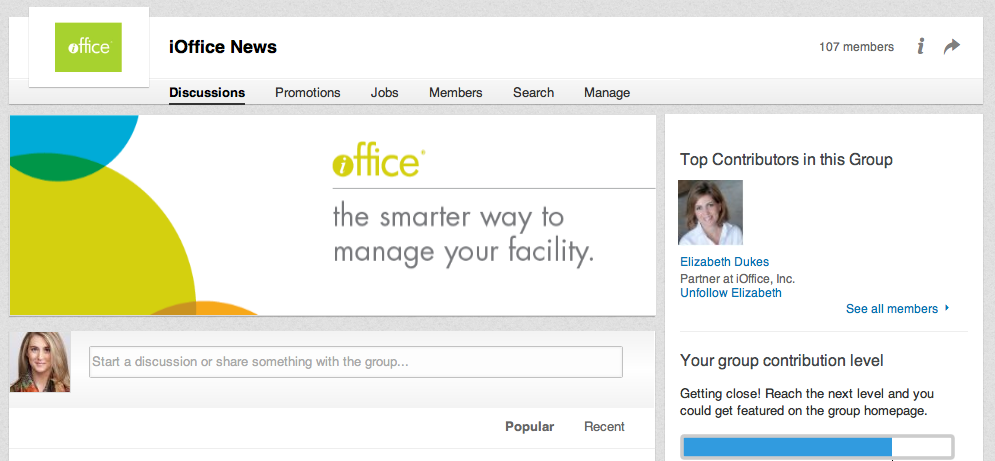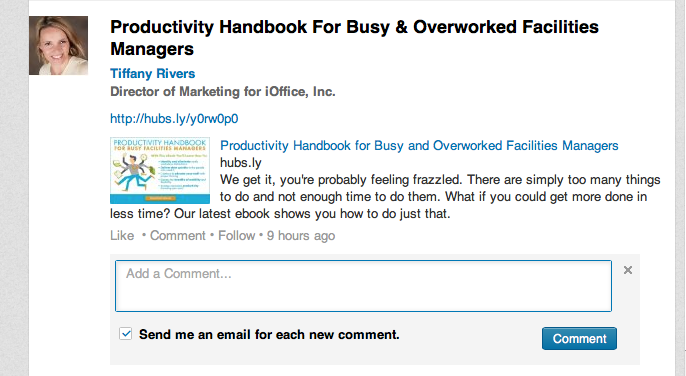Why Facilities Managers Should Participate In LinkedIn Groups (and how)


LinkedIn is a powerful tool that, when used correctly, can propel your career forward. It’s also the perfect platform to share your thoughts, learn new things and connect with other like-minded individuals. There’s a whole world of LinkedIn Groups to explore, from broad topics like general Facilities Management and more selective groups pertaining to your specific field, products, and FM challenges. Here’s how to make the most of groups on LinkedIn as a facilities manager.
Connecting is part of who we are as professionals. We are constantly learning, engaging and sharing our  thoughts – which is how we continue to grow in our industry. LinkedIn Groups are a great resource for FMs and office managers looking to expand their horizons. Here’s all you need to know about them, and how to make them work for you.
thoughts – which is how we continue to grow in our industry. LinkedIn Groups are a great resource for FMs and office managers looking to expand their horizons. Here’s all you need to know about them, and how to make them work for you.
Follow A Few Large Groups First
With over 2.1 million (yes, million) groups to choose from, where do you start? A simple search will help narrow it down for you. If you’re a facilities manager, a few groups to start with are Facilities Management Professionals International and International Facilities Management Association. Both groups are rather large with over 40,000 members, but this gives you a starting point and you can jump to other groups from your suggestions page. If you manage an office, a few groups you might be interested in are Office Manager Networking Group and Workplace Evolutionaries.
Take your time when joining groups, see what types of posts are common, and if you find them relevant to your position. Once you get a feel for the personality of the members, you will have a better idea of which groups you want to stay with and participate in.
Choose Your (limited) Groups Wisely
You may or may not know that LinkedIn limits the number of groups you can join. This is probably to prevent people from spamming multiple groups and irritating the members who are there to learn and network. However, there is a little trick to getting around the 50 limit. By joining the subgroups of main groups you can be part of more than 50. You must be a member of the main group before you join a subgroup, which are much more defined than many of the larger groups such as IFMA’s subgroup Environmental Health & Safety.
How To Post In LinkedIn Groups
1). Login to LinkedIn and select Interests –> Groups from the drop-down toolbar.

2). You will be sent to your Group Dashboard. To see all of your Groups, select “view more”.

3). To enter a group, simply click on the image for that group. You will be redirected to the home page where you will see the topics members have posted. Here you can view posts by “popular” or “recent” and you can see the top contributors and your personal contribution level.
There are five contributor levels and they are as follows: Getting Started • Finding An Audience • Making An Impact • Building Influence • Top Contributor. According to LinkedIn, “to increase your contribution level, start interesting discussions and comment thoughtfully on other group members’ discussions. As people interact more with you, you’ll see your score go up”.
If you would like to begin a new discussion, you may do so by typing in the “start a discussion or share something with the group…” section. If you enter a link, a preview will appear where you can select the image you want to post and change or alter the title and the explanation tab.
It’s always a good idea to read the group rules before you begin posting your own content. This can be found by clicking the information “i” at the top right section of the homepage. This page also displays the leader of the group, when it was started and other information that may be of relevance to you. You can also edit your settings and email preferences here and if you want to allow members to message you or not.

4). If you would like to comment on an existing post or ask a question, simply select “comment” under that post and a text box will appear. Be sure to spell check and reread your entry before hitting the “comment” button to submit, once submitted you have 15 minutes to edit your comment’s text. Some groups have moderators who must approve comments, this may be the case if your comment doesn’t appear right away.

5). Sometimes you find a group just isn’t for you, and that’s okay! To leave a group you’ve already joined, hover your mouse over the button that says “member” on the top right side of your homepage when in that group. You’ll see the button change to say “leave”. Click the leave button, and move on to another group that suits your fancy!
Participating in a growing global community is only going to increase your value in the facilities management industry. By making these connections now, you’ll be grateful that future job searches and introductions are much easier to do when you have a network of people you’ve communicated with throughout your career. It’s important to meet other FMs, learn about their challenges and their solutions you may not have been exposed to before. The facilities management world is constantly changing, and this is just one simple way we can try to keep up!
